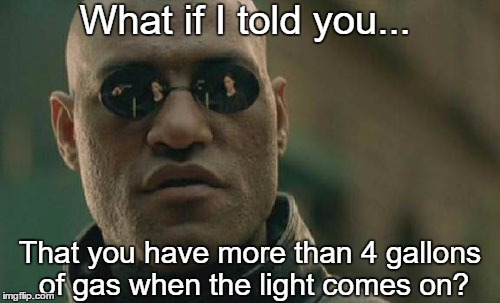+\- 10-15 miles seems insignificant to me. I'd think it's rare to travel with such inadequate planning in this day and age of smartphones, mapquest etc.
Your original question was "Why do you need to push it so far? Why would gassing up at 1/8-1/4 tank be such an inconvenience or detriment?". I know I still have 180 miles left on a 60 mph highway when I'm down to the 1/4 tank mark. Why would I fill up three hours early if I knew there fuel available on my route 2 1/2 hours down the road?
Further, anyone that routinely measures their fuel consumption should be able to tell how much travel is left on a tank of gas. Regardless of what the dash readout states.
No. This was discussed when the 2013 CX-5 was first released in early 2012 and, while plenty of us speculated about how much fuel was left, nothing was as definitive as the "running until sputter" test was performed. Keep in mind, the AWD and FWD models use different fuel tanks and different fuel metering strategies to try to achieve similar fuel level reporting goals (the AWD has two separate fuel measuring devices). Therefore this test is only directly applicable to AWD models.
Interestingly, although Mazda claims there is 2.6 US gallons of remaining fuel level in the 2013 AWD and FWD CX-5 when the low fuel level indicator illuminates, they indicate differing amounts of "invalid fuel" between the FWD and AWD. I interpret "invalid fuel" to mean the fuel remaining in the tank once the fuel pump starts to suck air. For the 2013 AWD this is 0.12 US gal. and the FWD has 0.359 US gal. (or about three times as much unusable fuel).
If my interpretation is correct, the AWD has 2.48 US gal. of useable fuel when the light illuminates
and the FWD has 2.241 US gal. useable fuel left. Rounding error from tenths of a liter to gallons accounts for the specification to thousandths of a gallon, obviously there are variables greater than that.
Apparently the low fuel warning light is operated by a different means than the primary fuel sender because it's illumination does not occur simultaneously with the extinguishing of the last fuel level bars (from experience). Mazda specifies a range of remaining fuel that will result in only the last fuel level bar being active and it is the same range regardless of FWD or AWD:
1.6 US gal.-2.1 US gal.
I do not believe the "invalid fuel" is counted in this number. In other words, there should be approximately 1.6 US gal. of useable fuel when the last fuel bar goes off. Of course the amount of useable fuel could vary slightly depending upon the attitude of the vehicle both when the fuel bar extinguishes and also when the pump starts sucking air.

